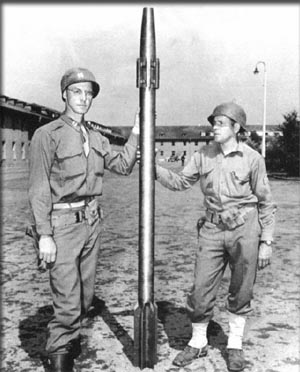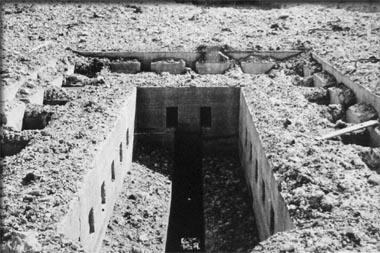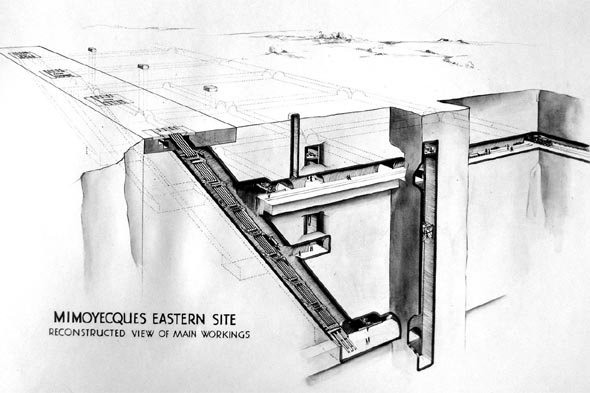The V-3:
Hitler's Super Cannon
|

A
prototype of the V-3 at Laatzig, Germany, in 1942.(Bundesarchiv
CC-BY-SA 3.0)
|
The Third Reich produced a number of "Vengeance"
weapons during WWII. Most people are familiar with the V-1:
the first ever cruise missile and the V-2: the first ever ballistic
missile used in war. There was a lesser-known third Vengeance
weapon the German's deployed, however. It wasn't a missile,
but a gun. A really big gun. So large some people called it
a "Super Cannon."
The story of the V-3 Super Cannon actually goes
back to WWI. During that war, the Germans came up with several
guns that pushed cannon technology at the time to its limit.
One of these devices was officially named the "Kaiser Wilhelm
Geschütz," gun, but was better known by the moniker "The Paris
Gun." The Paris Gun had the longest barrel of any piece of artillery
used during WWI. It was capable of launching a 234-pound projectile
up to 81 miles. In March of 1918, the Germans parked several
of these weapons about 75 miles away from the city of Paris
and started bombarding it. The cannon was so distant from the
metropolis that it couldn't be heard and the populace at first
thought they were being bombed by high-attitude zeppelins.
While this gun was successful in terrorizing the
citizens of Paris, it wasn't extremely effective as a military
weapon. The shell was relatively small and the accuracy was
low enough that it couldn't be directed against any particular
asset (like a munitions factory). The gun also suffered from
a number of problems that plague all designs of very large cannons.
First of all, in order to get the shell up to the speed necessary
to send it over 80 miles, the barrel of the gun had to be impractically
long. The Paris gun's 111-foot (34m), long barrel was so big
that it sagged and needed support cables to keep it straight.
Also, the charge to drive the shell out of the long gun was
so large and the force applied by the shell as it raced up the
barrel was so high, that it eroded the interior of the barrel
with each shot. Each shell had to be slightly larger than the
one before it to compensate for this, and after 65 shots, the
barrels had to be sent back to the manufacturer to be redone
completely.
|

A
patent drawing by Haskell showing a cross-section of the
gun with the multiple chambers.
|
Even with all these disadvantages, however, the
French were impressed with Germany's ability to bombard a target
at a great distance. The French military were soon working on
plans to build their own super cannon. They wanted a super cannon
that would have the range of the Paris gun, but without all
the problems.
Designing
a Super Cannon
Munitions designers had actually been thinking
about these issues for more than a half century before WWI.
In the late 1850's two U.S. men, Azel Storrs Lyman and James
Richard Haskell, collaborated on a plan for a gun that would
allow the shell to be accelerated to extreme speeds without
the need of a single, huge, destructive charge at the base of
the weapon to propel it. In their design, a normal-sized charge
would be set off at the base of the barrel and as the shell
moved up the barrel it would pass side chambers with additional
supplemental charges. As the shell passed by these chambers,
the charge in each would be set off. This would allow the pressure
behind the shell to be kept high as it accelerated out of the
barrel without using a large, single, damaging charge at the
base.
A test version of the "Lyman-Haskell multi-charge
gun" was constructed at the Frankfort arsenal in Philadelphia,
PA, on the instructions of the U.S. Army's Chief of Ordnance.
Unfortunately, the designers ran into some problems. They were
depending on the heat from the initial charge to set off the
supplemental charges as the shell passed each one of them. Unfortunately,
the seal between the shell and the barrel wasn't complete and
hot vapors leaking out in front of the shell would set off the
supplemental charges early. This actually had the effect of
slowing the shell down a bit instead of speeding it up. Eventually,
Lyman and Haskell abandoned their work.
But they were not the only ones who had come up
with this idea using multiple charges. In France, engineer Louis-Guillaume
Perreaux was working on a similar gun at almost the same time
as Lyman and Haskell. In 1864 he was granted a patent for this
multi-chamber weapon and later exhibited it at the 1878 World
Exhibition in Paris.
In 1918, when the French found themselves on the
wrong end of the Paris gun, they started researching long-range
cannons using this same multi-chamber idea. Before they could
finish a prototype, however, the war ended, the project was
shelved, and the plans for this super cannon were locked away
in an archive.
Hitler's
Super Cannon
When WWII started and France fell to the Germans
in 1940, Hitler's troops raided the archive and the plans fell
into the hands of August Cönders, a German weapons designer.
He was intrigued with multi-chamber design and felt it might
be just the mechanism he needed to build a gun that could launch
a shell an unheard of distance.
Cönders built a prototype of the gun using standard
20mm anti-aircraft gun barrels. It seemed to work, so it was
presented to Albert Speer, the Minister of Armaments and War
Production, as a way to fire rounds across the English Channel
into London from the shores of France.
|

Two
U.S. soldiers pose with a captured V3 finned projectile.
|
With that goal in mind, Cönders was given the
money to build a larger prototype at the proving ground near
Magdeburg. Here he ran into some problems. Like Lyman and Haskell,
vapors were sneaking past the shell and setting off the supplemental
charges early. A piston-like device was designed and placed
between the primary charge and the shell to seal the barrel.
This took care of the problem.
To hide its true goals, the project was given
the name Hochdruckpumpe which means "High Pressure Pump"
(sometimes referred as "HDP"). It was also later known by the
name Fleißiges Lieschen which means "Busy Lizzie."
To further reduce the damage to the barrel during
firing, it was decided the shells would be stabilized in flight
by giving them fins. Most shells fired from guns contact the
sides of the barrel where a spiral groove gives them a spin
as they exit the gun. This can quickly wear down the insides
of the barrel especially if the projectile is moving very fast
(this was one of the main problems for the Paris Gun). By using
the fins, the wear on the barrel could be greatly reduced.
Fortress
Mimoyecques
By September of 1943, the tests had been successful
enough that Hitler approved the start of work on an operational
site near the French town of Mimoyecques, about 5 miles from
the channel. The location was on a steep, chalk hill. Slave
laborers were brought in to tunnel through the rock and create
a series of passages.
The site was designed not to house just one super
cannon, but fifty. Hitler wanted to be able to bombard the city
of London almost continually, and with so many cannons, he would
be able to keep firing some while the others were being reloaded.
It was estimated that installation, when in full operation would
be able to bombard the city at the staggering rate of 300 rounds
an hour. The plan called for two different complexes at the
site, each with 25 guns. A single complex would consist of five
tunnels, or drifts, that ran up at a steep angle under the hillside
to where it emerged at the top. Inside these tunnels five cannons
would be stacked on top of each other. An underground railway
would supply both installations with shells and the explosives
necessary to send the warheads the 103 miles across the channel
to London.
Because the cannons would be so long (around 417
feet), they could not be aimed and would forever be fixed on
London. Protected by thick concrete on top and heavy, armored
doors over each drift when it was not in use, the Germans hoped
Fortress Mimoyecques would be impregnable.

The remains
of one of the firing ports of the V-3 cannons at Mimoyecques.
|
Such was not the case, however. The British were
already taking a heavy interest in that section of France as
the Germans were using it as alocation to launch their V-1 and
V-2 rockets. When recon planes showed the Germans building a
major installation at Mimoyecques, the British weren't really
sure what they were doing, but it didn't look good to them.
On July 6th, of 1944, they sent a squadron of Lancaster bombers
to drop 11,900 pound "Tallboy" earthquake bombs on the location.
Normal bombs would have gone off on the surface doing little
damage to the concrete, but the Tallboys penetrated deep into
the ground, creating an earthquake like effect and destroying
the installation before it could ever fire a shot.
Luxembourg
Bombardment
The destruction of Fortress Mimoyecques did not
end the Germans interest in super cannons, however. Late in
1944, two smaller, super cannons with 160 foot long barrels
were assembled near Trier, Germany. They were pointed at the
city of Luxembourg 27 miles away which had been in Allied hands
since September of that year. Operation of the guns was somewhat
hampered by damage to the German rail system so that shells
and the propellant charges were in short supply. Even so, the
two guns fired 183 rounds before they had to be moved to avoid
being captured. Of those 183 rounds, 142 hit the city, killing
10 people and wounding 35 others.
The Germans considered using the guns again during
the war, but the effort to move and set them up turned out to
be too great.
In the end, while the super cannon was a fascinating,
technical achievement, it wasn't a very practical weapon. Unlike
the V-1 and V-2 launch sites, these huge gun emplacements weren't
at all mobile. Even if they had remained undiscovered until
they became operational, the Allies would have soon ascertained
their locations and they would have been subject to heavy air
attacks that sooner or later would have put them out of business.
What remained of the Luxembourg guns was captured
by the Allies and shipped to the United States to be studied
before being destroyed in 1948.
Project
Babylon
Even with the ineffectiveness of the German guns,
interest in building a super cannon continued even to the end
of the 20th century. In 1988, Iraqi president Saddam Hussein
decided to build a series of "super guns" based on the work
of Canadian artillery expert Gerald Bull. The project came to
halt, however, when Bull was assassinated near his apartment
in Brussels. Though no one has ever taken credit for the murder,
rumors suggest that Israeli agents may have had Bull killed,
fearing that his supergun might be used to lob shells at the
Jewish state. The parts of the "Babylon" gun that had already
been manufactured were seized by the British government and
a piece of it can be seen at the Imperial War Museum in Duxford.
|
A
diagram of the V3 site in France if it had become operational.

|

Copyright Lee Krystek 2017.
All Rights Reserved.